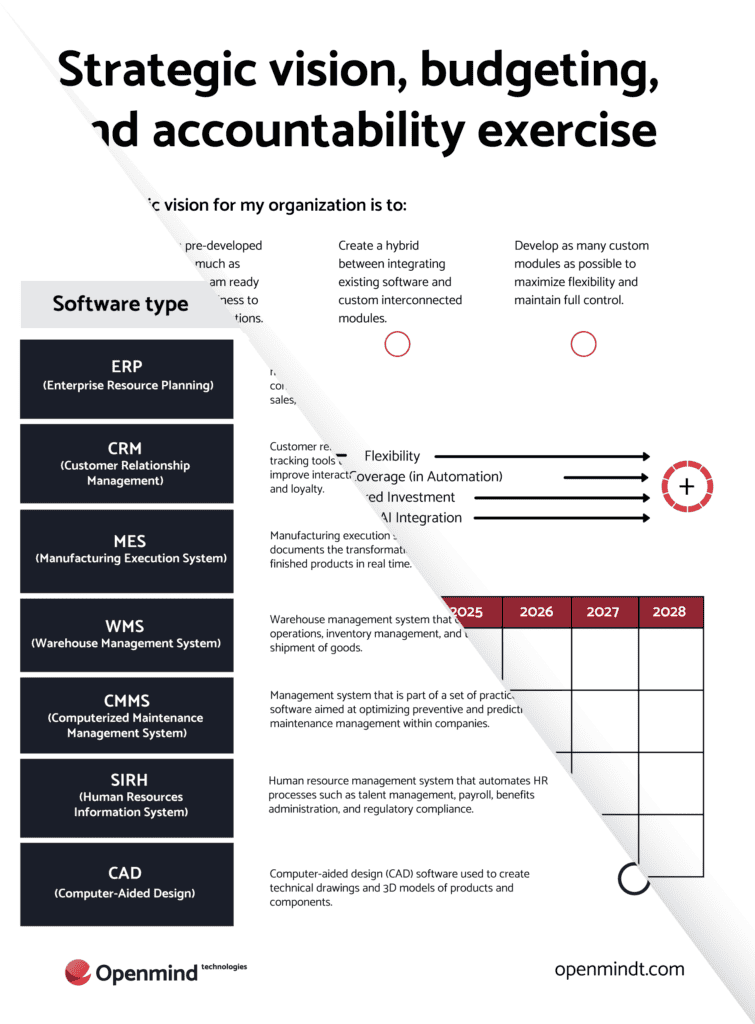Elevate your manufacturing strategy with key resources
Download our Technological Maturity Self-Assessment & Strategic Vision Exercise tools to assess your software ecosystem profile and to plan for future growth.

It’s no secret that the automation of internal processes greatly improves the efficiency and productivity of any modern manufacturing company. To implement this process, several technological tools are available on the market, but you still have to choose the right ones.
In this article, we will introduce two tools that are fundamental to companies wanting to be a part of Industry 4.0: Integrated Management Software, commonly called ERP (Enterprise Resource Planning), and Production Control Software, also known as M.E.S. (Manufacturing Execution System).
In addition to clarifying their different objectives, we will list their differences to help you understand how they complement each other in the achievement of your various strategic objectives.

The E.R.P. facilitates the creation and management of basic schedules for production, use of materials, deliveries, and shipments. And it allows the gathering of business information. We are talking about high-level functions here.

The M.E.S is a tool that facilitates the planning of operations and the management of activity reports on the production chain by collecting complete data in real time. This therefore results in better control of costs, resources and quality of the finished products.

The E.R.P. is mainly used by senior executives of a company to answer the strategic “why” of the company, while the M.E.S. instead, is a response to the operational “how,” and helps in quick decision-making related to production.
The implementation of an E.R.P. helps to clarify the vision of the company, assists in strategic planning, and allows to effectively coordinate the various departments of the company in the follow-up and the achievement of its objectives.
On the other hand, the M.E.S. helps answer urgent questions related to process optimization. It ensures the success of manufacturing operations and improves production efficiency.

As the two tools have different types of users, the nature of the data collected is also different. The M.E.S. collects and uses low-level data (e.g., quantity of raw material, dimensions, etc.) while the E.R.P. uses higher level data (e.g., finances, orders, etc.).

The most important feature of the M.E.S. is that its execution takes place in real time. This is necessary to properly reflect changes in the production chain (e.g., sudden failure, unavailability of stocks, etc.), and to adapt to them.
On the other hand, the E.R.P. does not always require a real-time update of the information it processes. The frequency can be daily, weekly, or monthly.

Download our Technological Maturity Self-Assessment & Strategic Vision Exercise tools to assess your software ecosystem profile and to plan for future growth.

In order to efficiently manage production, the M.E.S. connects directly to factory machines helping data collection and optimization in real time. The E.R.P., for its part, integrates with other company software solutions, such as CRMs, order management software, and, most importantly, the M.E.S.
Here is a table summarizing the M.E.S. versus the E.R.P.
There is no doubt that the integration of these two tools is an option that can’t be ignored, for any company that wants to achieve its objectives. For a 4.0 manufacturing company, strategic and operational objectives go hand in hand, and the integration of an M.E.S. and an E.R.P. will contribute to the unification of these two objectives.

M.E.S. and E.R.P integration is only optimal when the two tools communicate with each other by effectively sharing information and coordinating their operations. To make sure this is achieved, a strong framework is needed to define the integration between the two tools. It is with this in mind that the ANSI / ISA-95 standard was designed.
Created by the Instrumentation Systems and Automation Society (I.S.A.), the ANSI/ISA-95 standard serves as the reference for the implementation of an M.E.S. and defines the scope of its functions. It imposes a common terminology and compatibility standards with machines and other IT systems, such as the E.R.P. This is how data exchanges are facilitated between the different tools, and this is also what makes a system run smoother and be more efficient.
This standard provides a strict and necessary framework for the proper implementation of an M.E.S. and its integration with the various systems of the company, because the M.E.S. is much more effective when integrated with a company’s existing tools.
MES or ERP Why choose one or the other? The key is to understand that these two tools complement each other and are most effective when used together. The Industry 4.0 era is setting a new landscape for the manufacturing industry, and it is those who invest now who will have the upper hand in the future.
Subscribe to receive our exclusive tech updates & tips directly to your email.
Tell us more about your needs so that we can better route your project to our specific SWAT team.
1
During the brainstorming phase, we work with you to identify potential solutions to your business challenges to generate the technology response that aligns with your business objectives.
2
Through our requirements gathering process, we work closely with you to define and prioritize your needs, ensuring that our solutions are tailored to meet your specific requirements.
3
This phase marks the beginning of our partnership. We’ll finalize the project plan and establish clear communication channels to ensure a smooth and successful project execution.